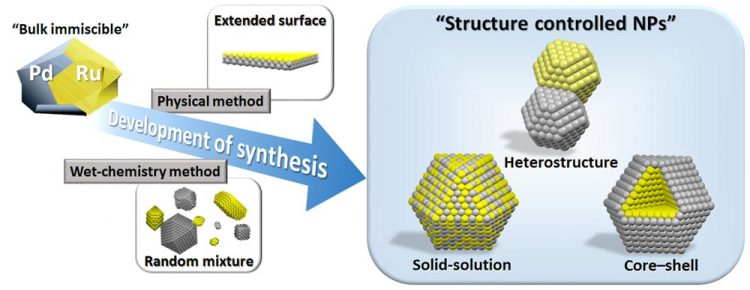Combining the elements palladium and ruthenium for industry

Figure: Synthesis of structure controlled bimetallic Pd-Ru nanoparticle alloys. ©2016 Dongshuang Wu, Kohei Kusada, Hiroshi Kitagawa
The chemical elements palladium (Pd) and ruthenium (Ru) are both used separately in the chemical industry. For a long time, researchers have thought that combining the two could lead to improved and novel properties for industrial applications. However, the two elements do not readily mix together to become a single material.
A study published in the journal Science and Technology of Advanced Materials reviewed the latest research into the fabrication of Pd-Ru bimetallic nanomaterials.
Early research from the past two decades showed that simply combining Pd and Ru nanoparticles led to a mixture with better properties for industrial catalytic purposes than either of the two elements alone. Since then, many groups have reported on Pd-Ru alloy nanoparticles. By varying the fabrication methods and compositions of Pd and Ru, Pd-Ru nanomaterials with different properties arise that can be suitable in industrial applications.
In 2010, Hiroshi Kitagawa from Japan’s Kyoto University and colleagues fabricated a “solid-solution alloy” (involving the addition of the atoms of one element to the crystalline lattice of the other in a high-temperature reaction) from two neighbour elements of Pd in the periodic table, silver (Ag) and rhodium (Rh). The resultant material had attractive properties for industrial purposes, including the ability to absorb hydrogen. Rh is important in a variety of reactions in the automotive industry as well as industrial exhaust gas treatment. But it is scarce and expensive. The success of Ag-Rh led the team to speculate that, due to their similarities, combining Pd and Ru into solid-solution alloy nanoparticles might lead to a material with similar properties, providing a potential alternative to Rh.
In 2014, the team was the first to synthesize Pd-Ru solid-solution alloy nanoparticles. They found the Pd-Ru nanoparticles had higher catalytic activities compared to Ru or Pd nanoparticles. More recently, they found these nanoparticles were highly active in a catalytic process important for purifying harmful gases from exhaust gas – even outperforming Rh nanoparticles.
Further research is needed to understand how varying the size of bimetallic material affects its physical and chemical properties. For example, research has found that growing less than five ultrathin Pd films on Ru causes the resultant material to be inert to oxygen even though Pd itself is highly reactive to it. Theoretical modelling will also be important for predicting and explaining the properties of PdRu and other nanomaterials, the study concludes.
For further information please contact:
Dongshuang Wu, Kohei Kusada, Hiroshi Kitagawa*
Division of Chemistry, Graduate School of Science, Kyoto University,
Kitashirakawa, Oiwake-cho, Sakyo-ku, Kyoto 606-8502, Japan
*E-mail: kitagawa@kuchem.kyoto-u.ac.jp
Article information
“Recent progress in the structure control of Pd–Ru bimetallic nanomaterials”,
Dongshuang Wu, Kohei Kusada, Hiroshi Kitagawa
Science and Technology of Advanced Materials Vol. 17 (2016) p. 1221727
Published online: 19 Sep 2016
http://tandfonline.com/doi/full/10.1080/14686996.2016.1221727
Journal Information
Science and Technology of Advanced Materials (STAM) is the leading open access, international journal for outstanding research articles across all aspects of materials science. Our audience is the international materials community across the disciplines of materials science, physics, chemistry, biology as well as engineering.
The journal covers a broad spectrum of materials science research including functional materials, synthesis and processing, theoretical analyses, characterization and properties of materials. Emphasis is placed on the interdisciplinary nature of materials science and issues at the forefront of the field, such as energy and environmental issues, as well as medical and bioengineering applications
http://tandfonline.com/loi/tsta20#.VrgX82fotYU
For more information about the journal Science and Technology of Advanced Materials, contact
Mikiko Tanifuji
Publishing Director
Science and Technology of Advanced Materials
Email: TANIFUJI.Mikiko@nims.go.jp
Associated links
Media Contact
All latest news from the category: Materials Sciences
Materials management deals with the research, development, manufacturing and processing of raw and industrial materials. Key aspects here are biological and medical issues, which play an increasingly important role in this field.
innovations-report offers in-depth articles related to the development and application of materials and the structure and properties of new materials.
Newest articles

Silicon Carbide Innovation Alliance to drive industrial-scale semiconductor work
Known for its ability to withstand extreme environments and high voltages, silicon carbide (SiC) is a semiconducting material made up of silicon and carbon atoms arranged into crystals that is…

New SPECT/CT technique shows impressive biomarker identification
…offers increased access for prostate cancer patients. A novel SPECT/CT acquisition method can accurately detect radiopharmaceutical biodistribution in a convenient manner for prostate cancer patients, opening the door for more…

How 3D printers can give robots a soft touch
Soft skin coverings and touch sensors have emerged as a promising feature for robots that are both safer and more intuitive for human interaction, but they are expensive and difficult…





















